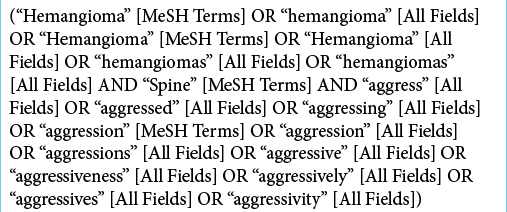- Department of Neurosurgery, Hospital do Mandaqui, São Paulo, Brazil.
- Department of Neurosurgery, Instituto de Assistência Médica ao Servidor Público do Estado de São Paulo, São Paulo, Brazil.
Correspondence Address:
Rayan Haquim Pinheiro Santos
Department of Neurosurgery, Instituto de Assistência Médica ao Servidor Público do Estado de São Paulo, São Paulo, Brazil.
DOI:10.25259/SNI_683_2020
Copyright: © 2020 Surgical Neurology International This is an open-access article distributed under the terms of the Creative Commons Attribution-Non Commercial-Share Alike 4.0 License, which allows others to remix, tweak, and build upon the work non-commercially, as long as the author is credited and the new creations are licensed under the identical terms.How to cite this article: Rayan Haquim Pinheiro Santos1, Caio Nuto Leite França1, Victor Dinelli Guimarães1, Cezar Kabbach Calaça Prigenzi1, Emilio Afonso França Fontoura1, Ricardo Vieira Botelho2. Aggressive vertebral hemangiomas in asymptomatic patients: A review. 22-Dec-2020;11:453
How to cite this URL: Rayan Haquim Pinheiro Santos1, Caio Nuto Leite França1, Victor Dinelli Guimarães1, Cezar Kabbach Calaça Prigenzi1, Emilio Afonso França Fontoura1, Ricardo Vieira Botelho2. Aggressive vertebral hemangiomas in asymptomatic patients: A review. 22-Dec-2020;11:453. Available from: https://surgicalneurologyint.com/surgicalint-articles/10478/
Abstract
Background: Hemangioma is the most common benign tumor of the spine. Most patients are asymptomatic, but some lesions can become aggressive, leading to spinal compression. Here, we reviewed the natural history and treatment of aggressive hemangiomas in asymptomatic patients.
Methods: An electronic review of the literature was performed regarding the diagnosis/treatment modalities for asymptomatic aggressive hemangiomas of the spine utilizing the Medline (PubMed) and Google Scholar databases.
Results: We selected four articles describing the diagnosis/management of four cases of aggressive, asymptomatic hemangiomas in patients averaging 11.25 ± 2.36 years of age. Three of the four patients were females, and all were followed an average of 36.5 ± 25 months. Notably, two of four patients required emergency surgery.
Conclusion: There is a paucity of the literature regarding the diagnosis and optimal therapeutic management of aggressive hemangiomas in asymptomatic patients, half of whom may present with acute neurological deterioration warranting emergency surgery.
Keywords: Hemangioma, Spinal neoplasms, Spine, Vertebra
INTRODUCTION
Hemangiomas are the most common benign tumors of the spine constituting 2–3% of all vertebral tumors. Most are located in the thoracic spine, with multi-level involvement in up to 30% of cases. Only 1% of hemangiomas are symptomatic (e.g., with back pain). Moreover, few result in significant myelopathy/compressive symptoms).[
Various treatment modalities include ethanol embolizations, radiotherapy, vertebroplasty, decompression, and/or spondylectomy.[
Here, we performed a systematic review of the natural history and treatment of aggressive hemangiomas in asymptomatic patients.
MATERIALS AND METHODS
We utilized the Medline (PubMed) and Google Scholar databases to study the history/treatment of asymptomatic aggressive hemangiomas (e.g., natural history longer than 12 months) [
Only 4 of 89 articles met the inclusion criteria for this the study [
Patients undergoing surgery, embolizations, or radiotherapy, were excluded from the study.
Four patients evaluated with aggressive hemangiomas
We identified four children averaging 11.25 years of age, including 3 females and 1 male, with aggressive hemangiomas followed for an average interval of 36.5 months.
Of the four initially asymptomatic patients, two later required emergent surgery within an average follow-up period of 28 months.[
DISCUSSION
The natural history for aggressive hemangiomas was described by four authors and involved just four patients. Of interest, two patients remained asymptomatic following their diagnosis for between 18 months and 6 years, while the other two required emergency surgery (at 20–36 months).
Hernalsteen et al. reported a 13-year-old female with T12 and L4 aggressive hemangiomas, within the next 6 years, these lesions showed significant shrinkage and neither became symptomatic or required intervention[
Jha and Choudhary described the natural history of an 11-year-old female with back pain, due to a T12 vertebral hemangioma treated with bracing alone.[
In a third case, Pretell-Mazzini et al. described a 13-year-old female with low back pain and an aggressive L1 hemangioma; suddenly, 3 years later, she acutely presented with a cauda equina syndrome requiring emergency surgery [
In the fourth case (e.g., 4th study), Uzunaslan et al. described using propranolol to treat T5 aggressive hemangioma.[
CONCLUSION
There is little information to determine the optimal treatment for initially asymptomatic aggressive vertebral hemangiomas. However, as noted in this series of four patients, two went on to demonstrate acute neurological deterioration 20–36 months following this diagnosis.
Declaration of patient consent
Patient’s consent not required as patients identity is not disclosed or compromised.
Financial support and sponsorship
Nil.
Conflicts of interest
There are no conflicts of interest.
References
1. Acosta FL, Sanai N, Chi JH, Dowd CF, Chin C, Tihan T. Comprehensive management of symptomatic and aggressive vertebral hemangiomas. Neurosurg Clin N Am. 2008. 19: 17-29
2. Hernalsteen D, Cosnard G, Duprez T. Long-term (6-year) follow-up of untreated multiple aggressive vertebral haemangiomas in an adolescent. Pediatr Radiol. 2004. 34: 831-2
3. Jha B, Choudhary AK. Unusual cause of back pain in an adolescent patient: A case report and natural history of aggressive vertebral hemangioma in children. Pain Physician. 2008. 11: 687-92
4. Ji X, Wang S, Oner FC, Bird JE, Lu N. Surgical management of enneking stage 3 aggressive vertebral hemangiomas with neurological deficit by one-stage posterior total en bloc spondylectomy: A review of 23 cases. Spine (Phila Pa 1976). 2020. 45: E67-75
5. Pretell-Mazzini J, Chikwava KR, Dormans JP. Low back pain in a child associated with acute onset cauda equina syndrome: A rare presentation of an aggressive vertebral hemangioma: A case report. J Pediatr Orthop. 2012. 32: 271-6
6. Uzunaslan D, Saygin C, Gungor S, Hasiloglu Z, Ozdemir N, Celkan T. Novel use of propranolol for management of pain in children with vertebral hemangioma: Report of two cases. Childs Nerv Syst. 2013. 29: 855-60







